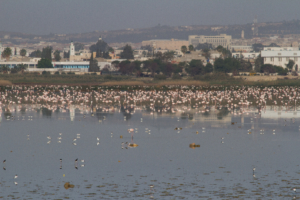
Sebkhet Sejoumi is a wetland of great ecological value in the middle of an urban area (the South-western suburb of Greater Tunis). Its importance, particularly for migratory waterbirds, has been recognised by the attribution of several international statuses: Wetland of International Importance (the Ramsar Convention), Important Bird Area (IBA), and Key Biodiversity Area (KBA). It is also the fourth most important wintering site for waterbirds in North Africa (Sayoud et al., 2017).
This wetland ecosystem, which most natural functions are still preserved despite the numerous degradations it has suffered from, also offers multiple services to the human populations living in the lakeside: flood protection, grazing, fodder collection, mitigation of some climate change impacts, and recreational services. Sebkhet Sejoumi is, therefore, de facto, one of the priority natural sites for conservation in Tunisia.
A dynamic territory highly modified by human activities
Results, produced by the Mediterranean Wetlands Observatory [1] of the Tour du Valat (MWO/TdV), of the monitoring of spatial dynamics of the wetland and its catchment area, using satellite images covering the past 30 years, revealed that the surface water of the sebkha has decreased considerably since the late 1980s and that it is drying out significantly (Figure 1). These changes seem to be directly related to the automatic pumping system, implemented by the public authorities in 2004, as a response to the problem of repeated floods affecting some lakeside neighborhoods of Sebkhet Sejoumi.
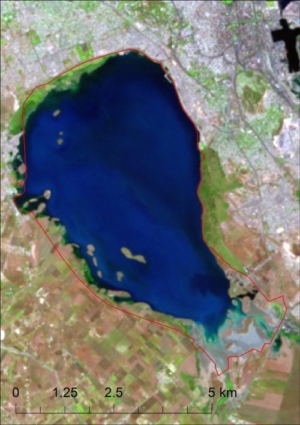 |
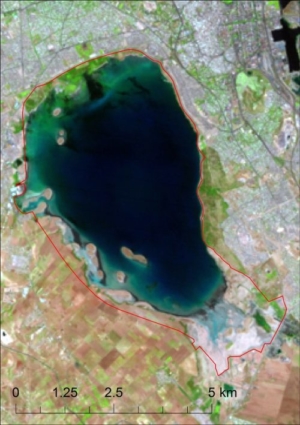 |
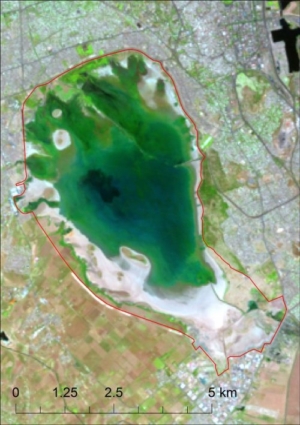 |
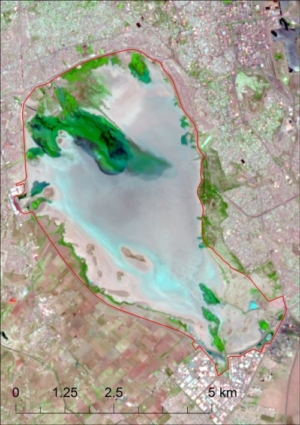 |
Figure 1: Satellite images showing the evolution of surface waters within Sebkhet Sejoumi between 1987 (top left), 2000 (top right), 2010 (bottom left) and 2018 (bottom right). All the four images are derived from Landsat and Sentinel-2 time series and were acquired in June.
Nevertheless, questions remain regarding the impact of such a mechanism on the other components of the ecosystem of Sebkhet Sejoumi (e.g., its biodiversity), its real effectiveness and, beyond that, whether other solutions (including those based on Nature) can be provided. Indeed, on the latter issue in particular, analyses of Earth Observation (EO) data also show that the recurrence of floods, as well as the significant damage they cause, are above all a direct consequence of a rapid and unplanned urban development in the entire catchment area. The fact is that, over the past three decades, urbanisation has destroyed hundreds of hectares of arable and natural lands, mostly in floodplains surrounding the northern and western banks of the sebkha, which should never have been built on or settled by human populations (Figure 2).
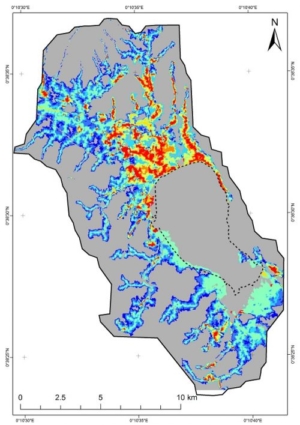 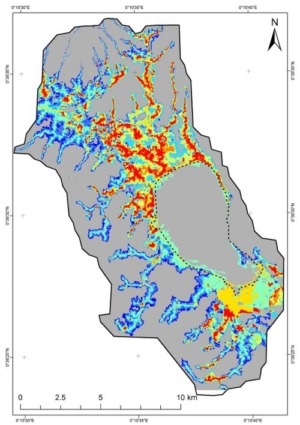 |
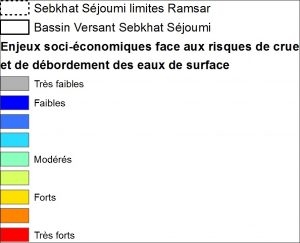
Figure 2: Maps of the spatial dynamics of socio-economic issues in relation with the flood hazards (1987 in the left and 2018 in the right)
What could be the adequate responses?
Unfortunately, urban expansion, pollution and land filling continue in silence – the sebkha would have lost 20% of its natural wetland habitats between 1987 and 2018 – while locals still consider the wetland to be the source of floods, odour nuisances, and mosquitoes.
Moreover, with the rapid increase of the population, new socio-economic issues have emerged in recent years, leading to the elaboration of a Management and Valorisation Plan for the site. The latter is in the process of being evaluated by the competent authorities, in particular for its impacts on the environment and the biodiversity. However, it is important to notice that, in its current form; this Plan seems totally inadequate to meet all the main environmental challenges identified for Sebkhet Sejoumi and could even be a source of new threats on its highly valuable ecological character.
Indeed, according to the recent studies carried out by the TdV, with the support of its local partners (Réseau Enfants de la Terre and the Association “Les Amis des Oiseaux”) and MedWet [2], the management and valorisation solutions to be proposed should be less based on the sebkha itself, but more oriented towards a better governance at the scale of the entire catchment area, with a more rigorous control of the urbanisation and a significant improvement of the water management in the upstream. They, therefore, recommend the following:
- Strongly encourage the authorities to halt any progress in construction on the banks of the sebkha (especially in the northwest, west and southwest);
- Set up more efficient systems for the evacuation of rainwater, especially in the most affected districts by recurrent floods;
- Improve the automatic pumping system of the sebkha so that it can protect the human populations from flood hazards while respecting the natural cycles of the wetland;
- Improve the wastewater collection systems in all the districts bordering the sebkha and systematically connect them to sewage treatment plants;
- Promote local and eco-friendly agricultural practices, by making the best use of their products, in order to halt speculations on arable lands;
- Carry out awareness-raising and advocacy actions with local residents and decision-makers (local, but also national), in favour of wetland conservation;
- Promote ecotourism and leisure activities in nature (e.g., birdwatching) to generate income for local populations, but also to raise awareness among visitors about the conservation of the site;
- Establish an ecological monitoring system for Sebkhet Sejoumi;
- Propose and test alternative and ecological solutions to control mosquitoes (e.g., mosquito traps) and avoid further water and soil pollutions due to the utilisation highly toxic chemicals; and
- Develop of an ambitious urban plan for Sebkhet Sejoumi and its catchment area, in consultation with all the concerned stakeholders and by putting the conservation of the ecosystem in its natural state as a baseline for any discussion, as it could also be a part of the solution.
Contact : Anis Guelmami [3], Project Leader at the Mediterranean Wetlands Observatory (MWO) – (e-mail [4])